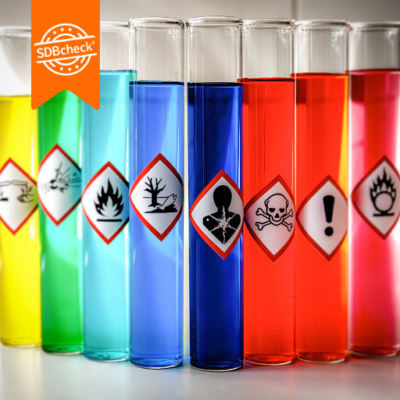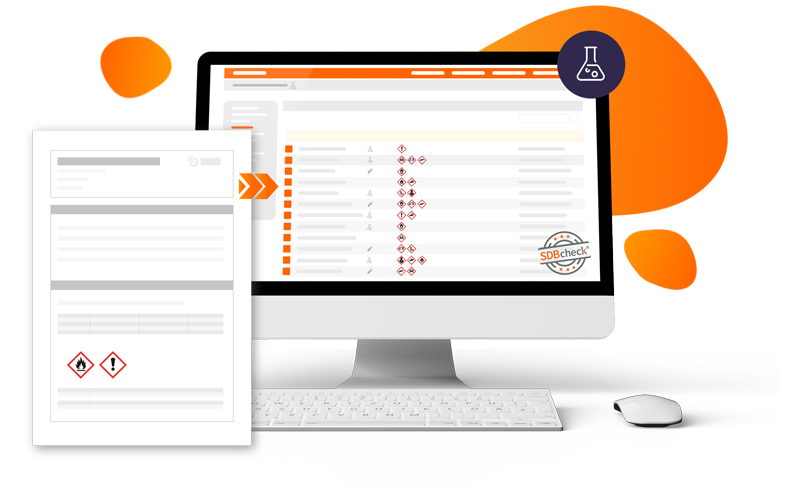
When handling hazardous substances, it is not only important to know what is dangerous, but also how to protect yourself properly. This is exactly where the P-phrases come in: They provide clear instructions on which safety measures must be observed when handling, storing or disposing of a hazardous substance.
While the H-phrases describe the hazards posed by a substance (e.g. toxic, corrosive or flammable), the P-phrases provide specific instructions – for example, “Wear protective gloves”, “Keep away from heat” or “Wash off thoroughly in case of contact with skin”.
In this article, we will show you how P-phrases are structured, which groups there are and how to apply these safety instructions correctly during operation. Of course, you will also find a complete overview of all P-phrases with their meaning – explained in a compact and practical way.
What exactly are P-phrases?
P-phrases, also known as precautionary statements, are standardized safety instructions that specify how to handle a hazardous substance in order to avoid risks to health and the environment. Like the H-phrases, they are part of the CLP Regulation [1] and supplement the GHS labeling on labels, in safety data sheets and in the list of hazardous substances.
Where can I find P-phrases?
P-phrases can be found on:
✔ Product labels with GHS symbols
✔ Sections 2 and 16 in the safety data sheet
✔ Operating instructions & instruction materials
✔ Hazardous substance labels in the warehouse or at workplaces
Why are P-phrases important in everyday working life?
While the H-phrases describe the hazard, the P-phrases give specific instructions for action. They help with this:
- Implement protective measures correctly
- Avoid accidents
- Comply with regulations for storage, disposal or first aid
P-phrases thus actively contribute to safety in the workplace – from correct handling to emergency care.
How are P-phrases structured?
P-phrases consist of an identification code (e.g. P280) and a standardized formulation such as:
P280: Wear protective gloves / protective clothing / eye protection / face protection.
The numbers are divided into five groups:

P2xx – Prevention

P3xx – Reaction to accidents

P4xx – Storage

P5xx – Disposal
All P-phrases at a glance

General information
| P101 | If medical advice is required, have packaging or label ready. |
| P102 | Keep out of the reach of children. |
| P103 | Read the label before use. |

Precautionary measures
| P201 | Obtain special instructions before use. |
| P202 | Read and understand all safety instructions before use. |
| P210 | Keep away from heat, hot surfaces, sparks, open flames and other ignition sources. Do not smoke. |
| P211 | Do not spray against an open flame or other ignition source. |
| P212 | Avoid heating while including and reducing the desensitizing agent. |
| P220 | Keep away from clothing and other flammable materials. |
| P222 | Do not allow contact with air. |
| P223 | Do not allow contact with water. |
| P230 | Keep moist with … |
| P231 | Handle and store contents under inert gas/…. |
| P232 | Protect from moisture. |
| P233 | Keep container tightly closed. |
| P234 | Store only in original packaging. |
| P235 | Keep cool. |
| P240 | Ground the container and the system to be filled. |
| P241 | Use explosion-proof electrical devices/ventilation systems/lighting systems/…. |
| P242 | Use non-sparking tools. |
| P243 | Take measures against electrostatic discharges. |
| P244 | Keep valves and equipment parts free of oil and grease. |
| P250 | Do not grind/bump/rub/… |
| P251 | Do not pierce or burn, even after use. |
| P260 | Do not inhale dust / smoke / gas / mist / vapor / aerosol. |
| P261 | Avoid inhalation of dust / smoke / gas / mist / vapor / aerosol. |
| P262 | Do not get in eyes, on skin or clothing. |
| P263 | Avoid contact during pregnancy and breastfeeding. |
| P264 | After use … wash thoroughly. |
| P270 | Do not eat, drink or smoke when using the product. |
| P271 | Only use outdoors or in well-ventilated rooms. |
| P272 | Do not wear contaminated work clothing outside the workplace. |
| P273 | Avoid release into the environment. |
| P280 | Wear protective gloves/protective clothing/eye protection/face protection. |
| P282 | Wear protective gloves with cold insulation and an additional face shield or eye protection. |
| P283 | Wear flame-retardant or flame-retardant clothing. |
| P284 | Wear respiratory protection [in case of insufficient ventilation]. |
| P231 + P232 | Handle and store contents under inert gas/…. Protect from moisture. |

Reactions to accidents
| P301 | IF SWALLOWED: |
| P302 | ON CONTACT WITH THE SKIN: |
| P303 | IF IN CONTACT WITH THE SKIN (or hair): |
| P304 | ON BREATH: |
| P305 | ON CONTACT WITH THE EYES: |
| P306 | ON CONTACT WITH CLOTHING: |
| P308 | IF exposed or concerned: |
| P310 | Call POISON CENTER/doctor/… immediately. |
| P311 | Call the POISON INFORMATION CENTER/doctor/… |
| P312 | Call a POISON CENTER/doctor/… if you feel unwell. |
| P313 | Seek medical advice / medical assistance. |
| P314 | If you feel unwell, seek medical advice/attention. |
| P315 | Get medical advice / attention immediately. |
| P320 | Special treatment urgently required (see … on this label). |
| P321 | Special handling (see … on this label). |
| P330 | Rinse out mouth. |
| P331 | DO NOT induce vomiting. |
| P332 | For skin irritation: |
| P333 | For skin irritation or rash: |
| P334 | Immerse in cold water [or apply a wet bandage]. |
| P335 | Brush off loose particles from the skin. |
| P336 | Thaw icy areas with lukewarm water. Do not rub the affected area. |
| P337 | In case of persistent eye irritation: |
| P338 | Remove any contact lenses if possible. Continue rinsing. |
| P340 | Move the person to fresh air and ensure unobstructed breathing. |
| P342 | For respiratory symptoms: |
| P351 | Rinse carefully with water for a few minutes. |
| P352 | Wash with plenty of water/… |
| P353 | Wash skin with water [or shower]. |
| P360 | Immediately wash contaminated clothing and skin with plenty of water and then remove clothing. |
| P361 | Remove all contaminated clothing immediately. |
| P362 | Remove contaminated clothing. |
| P363 | Wash contaminated clothing before wearing it again. |
| P364 | And wash before wearing again. |
| P370 | In case of fire: |
| P371 | For large fires and large quantities: |
| P372 | Explosion hazard. |
| P373 | NO fire fighting if the fire reaches explosive substances / mixtures / products. |
| P375 | Fight fire from a distance due to risk of explosion. |
| P376 | Eliminate leaks if possible without risk. |
| P377 | Leaking gas fire: Do not extinguish until the leak can be eliminated safely. |
| P378 | … for deletion. |
| P380 | Clear the surrounding area. |
| P381 | In case of leakage, remove all ignition sources. |
| P390 | Pick up spills to avoid material damage. |
| P391 | Absorb spillage. |
| P301+P310 | IF SWALLOWED: Call a POISON CENTER/doctor/… immediately. |
| P301+P312 | IF SWALLOWED: Call a POISON CENTER/doctor/… if you feel unwell. |
| P301+P330+P331 | IF SWALLOWED: Rinse out mouth. DO NOT induce vomiting. |
| P302+P334 | IF ON SKIN: Immerse in cold water or apply a wet bandage. |
| P302+P352 | IF IN CONTACT WITH SKIN: Wash with plenty of water/…. |
| P302+P335+P334 | IF ON SKIN: Brush off loose particles from skin. Immerse in cold water [or apply wet bandage]. |
| P303+P361+P353 | IF IN CONTACT WITH SKIN (or hair): Remove all contaminated clothing immediately. Wash skin with water/shower. |
| P304+P340 | IF INHALED: Remove person to fresh air and keep comfortable for breathing. |
| P305+P351+P338 | IF IN EYES: Rinse cautiously with water for several minutes. Remove any contact lenses if possible. Continue rinsing. |
| P306+P360 | IF ON CLOTHING: Wash contaminated clothing and skin immediately with plenty of water and then remove clothing. |
| P308+P311 | IF exposed or concerned: Call a POISON CENTER/doctor/… |
| P308+P313 | IF exposed or concerned: Get medical advice/attention. |
| P332+P313 | If skin irritation occurs: Get medical advice/attention. |
| P333+P313 | In case of skin irritation or rash: Seek medical advice/attention. |
| P336+P315 | Thaw icy areas with lukewarm water. Do not rub the affected area. Seek medical advice/medical assistance immediately. |
| P337+P313 | If eye irritation persists: Seek medical advice/attention. |
| P342+P311 | In case of respiratory symptoms: Call a POISON CENTER/doctor/…. |
| P361+P364 | Take off all contaminated clothing immediately and wash it before wearing it again. |
| P362+P364 | Take off contaminated clothing and wash it before wearing it again. |
| P370+P376 | In case of fire: Eliminate the leak if possible without risk. |
| P370+P378 | In case of fire: … use to extinguish. |
| P370+P380+P375 | In case of fire: Clear the surrounding area. Fight fire from a distance due to risk of explosion. |
| P370+P372+P380+P373 | In case of fire: Risk of explosion. Evacuate the area. DO NOT fight fire if the fire reaches explosive substances/mixtures/products. |
| P370+P380+P375+P378 | In case of fire: Clear the surrounding area. Fight fire from a distance due to risk of explosion. Use [… for extinguishing]. |
| P371+P380+P375 | In case of large fire and large quantities: Clear the surrounding area. Fight fire from a distance due to risk of explosion. |

Storage
P402Store in a dry place.
| P401 | Store according to … |
| P403 | Store in a well-ventilated place. |
| P404 | Store in a closed container. |
| P405 | Store under lock and key. |
| P406 | Store in a corrosion-resistant/… container with a corrosion-resistant inner lining. |
| P407 | Leave an air gap between stacks or pallets. |
| P410 | Protect from sunlight. |
| P411 | Store at temperatures not exceeding …°C / … °F. |
| P412 | Do not expose to temperatures exceeding 50 °C/122 °F. |
| P413 | Store bulk material in quantities of more than … kg/ … lbs at temperatures not exceeding … °C/… °F. |
| P420 | Store separately. |
| P402+P404 | Store in a dry place. Store in a closed container. |
| P403+P233 | Store in a well-ventilated place. Keep container tightly closed. |
| P403+P235 | Store in a well-ventilated place. Keep cool. |
| P410+P403 | Protect from sunlight. Store in a well-ventilated place. |
| P410+P412 | Protect from sunlight and do not expose to temperatures exceeding 50 °C/122 °F. |
| P411+P235 | Store at temperatures not exceeding … °C/… °F. Keep cool. |

Waste disposal
| P501 | Feed contents/container …. |
| P502 | Ask the manufacturer or supplier for information on reuse or recycling. |
| P503 | Ask the manufacturer/supplier/… for information on disposal/reuse/recycling. |
Using P-phrases correctly – that’s what matters
P-phrases are more than just formalities – they are an important part of occupational health and safety. Those who know and observe them create the basis for the safe handling of hazardous substances, protect employees and meet legal requirements.
In combination with the GHS pictograms, H-phrases and the safety data sheet, P-phrases form the basis for legally compliant labeling.
💡 Tip: With SDBcheck®, you can automatically document all relevant P-phrases in the hazardous substances register – centrally, up-to-date and legally compliant.
Professional references & references
[1]
Act now: Digital hazardous substance management with SDBcheck®
A legally compliant hazardous substance management does not have to be complicated or time-consuming. SDBcheck® helps you to implement all GHS requirements efficiently:
✔ Manage hazardous substances digitally – put an end to confusing Excel lists
✔ Safety data sheets always to hand – automatic updates and structured filing
✔ Meet legal requirements – ISO 14001 and 9001 compliant hazardous substances register easy to manage
✔ Protection for your team – keep employees informed at all times and ensure safety
➜ Use SDBcheck® now for simple, digital hazardous substance management!
Visit our webinar

Are you responsible for managing hazardous substances and struggling with confusing Excel lists? Are you missing a simple, digital solution to efficiently maintain your hazardous substances register and keep it up to date?
What you can expect:
✔ Legal basics explained clearly – what is really important
✔ Automated reading of safety data sheets – save time instead of typing
✔ Why a software solution is superior to Excel – efficiency, safety & transparency ✔ Step-by-step to digital hazardous substance management – from recording to release ✔ Simple updating & management – always up to date Transparency
✔ Step-by-step to digital hazardous substance management – from recording to release
✔ Easy updating & management – always up to date
✔ Safe release of hazardous substance information for employees – targeted & structured












